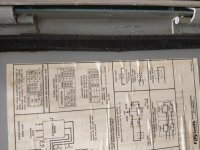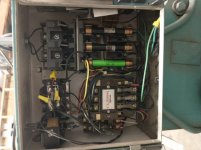Fish On
Hot Rolled
- Joined
- Feb 23, 2014
- Location
- Foley, Alabama
Just moved my shop to a different building. Had 240 single phase and an RPC, new place has 3 phase 208v. Wasn't sure which machines would be happy on 208 and which wouldn't, so (also partially influenced by a lack of time) figured I'd hook them up and see which ones weren't happy. Seems to just be my mechanical shear.
This is a hard starting flywheel driven machine. 5 hp, 230v nameplate rating, 15 amp motor. Fed 240v by RPC at the old shop, it would take a few seconds to spin up to speed, but didn't seem unhappy.
After getting power to it, I blipped the power on for a second to see which way the motor was rotating (wrong of course), so I swapped the 1 and 3 leads, turned power back on, and nothing. Leg 1 fuse was blown.
Purchased a few more fuses, started up the machine and it took quite some time to spin up to speed. 2 - 3 times what it used to, if I'm not mistaken. Shut it down as soon as it was up to speed, and the next time I go to start it, leg 1 fuse is already blown. Not sure at what point in the process the fuse is blowing, but didn't really see the point in burning up another $12 fuse to find out as it's clear it doesn't like 208v.
With just a few minutes left before Mcmaster shipment cutoff time, I did what research on buck boost transformers I could, but certainly did not establish enough of an understanding to be confident in my purchase.
Based on this calculator, it seemed I needed a pair (I'm still not understanding the 2 transformers for 3 phase, but I'm sure they'll come with a wiring diagram) of 500va units.
Buck and Boost Transformer Calculator - Schneider Electric United States
So I bought 2 of these with hopes of being able to install tomorrow when they arrive.
McMaster-Carr
Does it look like I've bought the right units (wall voltage measures 209, motor nameplate is 230. 5 hp, 15 amps. 1.15 service factor motor)? Do these things typically come with instructions/wiring diagrams suitable for someone who doesn't really understand what's going on inside?
This is a hard starting flywheel driven machine. 5 hp, 230v nameplate rating, 15 amp motor. Fed 240v by RPC at the old shop, it would take a few seconds to spin up to speed, but didn't seem unhappy.
After getting power to it, I blipped the power on for a second to see which way the motor was rotating (wrong of course), so I swapped the 1 and 3 leads, turned power back on, and nothing. Leg 1 fuse was blown.
Purchased a few more fuses, started up the machine and it took quite some time to spin up to speed. 2 - 3 times what it used to, if I'm not mistaken. Shut it down as soon as it was up to speed, and the next time I go to start it, leg 1 fuse is already blown. Not sure at what point in the process the fuse is blowing, but didn't really see the point in burning up another $12 fuse to find out as it's clear it doesn't like 208v.
With just a few minutes left before Mcmaster shipment cutoff time, I did what research on buck boost transformers I could, but certainly did not establish enough of an understanding to be confident in my purchase.
Based on this calculator, it seemed I needed a pair (I'm still not understanding the 2 transformers for 3 phase, but I'm sure they'll come with a wiring diagram) of 500va units.
Buck and Boost Transformer Calculator - Schneider Electric United States
So I bought 2 of these with hopes of being able to install tomorrow when they arrive.
McMaster-Carr
Does it look like I've bought the right units (wall voltage measures 209, motor nameplate is 230. 5 hp, 15 amps. 1.15 service factor motor)? Do these things typically come with instructions/wiring diagrams suitable for someone who doesn't really understand what's going on inside?






